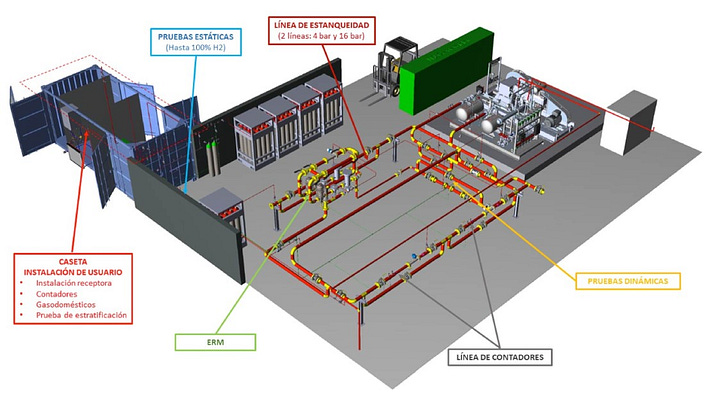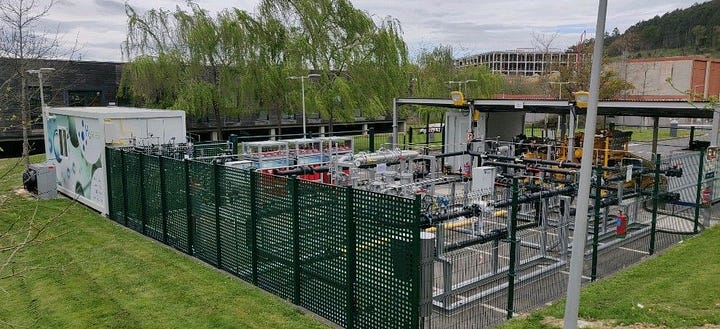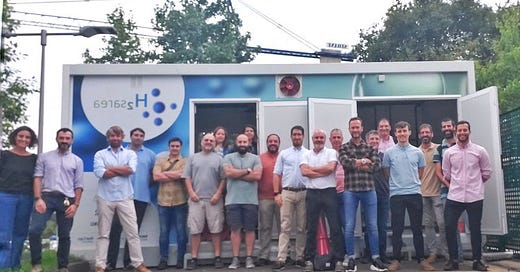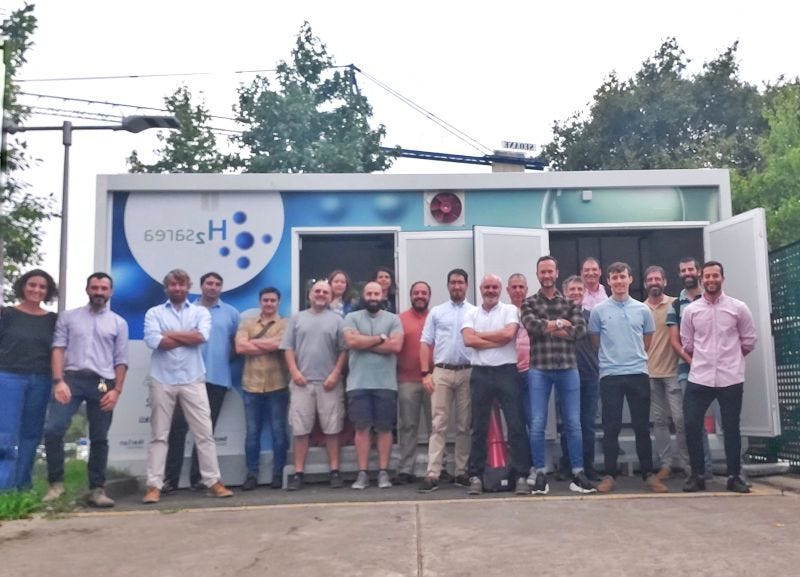39) Visita H2SAREA Nortegas
La semana pasada puede visitar la instalación de H2SAREA de Nortegas, me gustaría dar las gracias a Gotzon Garcia y Elena Silveira por las explicaciones que nos dieron. En el siguiente link tenéis explicado en una publicación este proyecto estratégico para el país. (https://lnkd.in/ei7Qm5b6).
Una de las cosas que más me ha sorprendido es el espíritu de cooperación que existe, ya que, Nortegas, segunda distribuidora nacional, comparte los resultados obtenidos de este proyecto de I+D con La Asociación Española del Gas, SEDIGAS. Dicha asociación representa al sector gasista español y quiere contribuir a la descarbonización de la sociedad.
En lo que respecta a la parte técnica, se ha mencionado que las nuevas tuberías que se instalan para distribución son de polietileno, siendo este un material 100% compatible con el #hidrógeno. Estos conductos son los que canalizan el gas hasta la fachada de nuestras casas y suelen rondar los 4-6 bar de presión.
Una vez en ese punto, mediante una unión polietileno-cobre se da paso al gas a nuestra casa, a una presión de 150 mbar, donde como todos podréis comprobar el material es cobre. Los quemadores en la caldera domestica pueden recibir hasta un 20% de hidrógeno (hasta ese porcentaje no cambia la clasificación de familia de gases(Norma UNE En 437)), aunque funcionen el dispositivo, se tienen que estudiar la eficiencia y la degradación que pueden sufrir.
A la hora de transportar el hidrogeno según las necesidades se emplean diferentes materiales para los hidroductos:
En el Proyecto #BENORTH2 (En el siguiente post lo tenéis explicado: https://lnkd.in/ewFWD5qr) donde se va construir un hidroducto de 15,6km para conectar las instalaciones de la CTCC de Amorebieta y la red de APA de gas natural localizada en la Posición 45-16/ #Arrigorriaga de Enagas, donde parten los gaseoductos de la red APA (MOP 16 bar) de Nortegas, donde se inyectará el hidrógeno producido en la CTCC de Boroa. El material del Hidroducto, de acuerdo al código ASME B31.12, será API 5L Gr. B (con un diámetro mínimo de 8”).
Por otra parte, en la infraestructura de distribución de hidrógeno para conectar la refinería de Petronor, S.A.-Repsol y el nuevo Parque Tecnológico de Abanto-Zierbena se emplearán las siguientes especificaciones:
-La tubería troncal del Hidroducto será: Ø 4" API 5L Gr. X-42. (Dext.= 114,3 mm).
-Los ramales de acometida a consumidores finales: Ø 2" API 5L Gr. B (Dext.= 60,3 mm).
Por otra parte, se han tratado otros temas como la iniciativa de convertir en ciudad 100% a Aberdeen City en Escocia o posibles estudios a realizar en el futuro, tales como, como afectaría un problema de #estratificación de una mezcla de GN/H₂ en un edificio donde el último piso no usa apenas la mezcla.
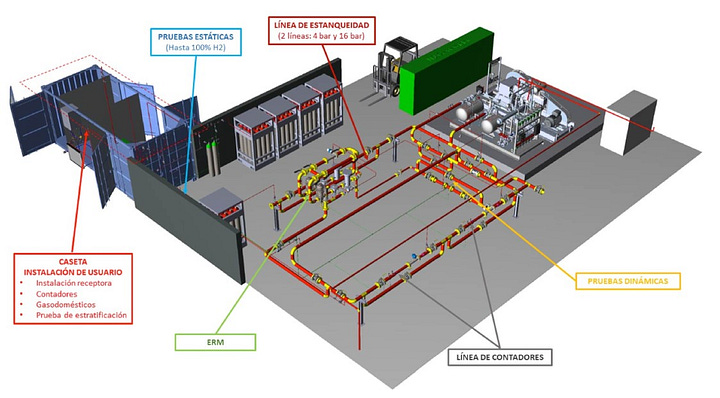
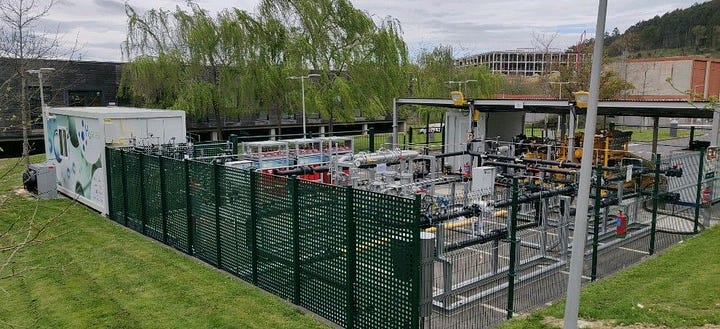
39) Visit H2SAREA Nortegas
Last week you can visit the H2SAREA Nortegas facility, I would like to thank Gotzon Garcia and Elena Silveira for the explanations they gave us. In the following link you have explained in a publication this strategic project for the country. (https://lnkd.in/ei7Qm5b6).
One of the things that has surprised me the most is the spirit of cooperation that exists, since Nortegas, the second national distributor, shares the results obtained from this R&D project with the Spanish Gas Association, SEDIGAS. This association represents the Spanish gas sector and wants to contribute to the decarbonisation of society.
Regarding the technical part, it has been mentioned that the new pipes that are installed for distribution are made of polyethylene, this being a 100% compatible material with #hydrogen. These ducts are the ones that channel the gas to the façade of our houses and are usually around 4-6 bar pressure.
Once at that point, through a polyethylene-copper union, the gas passes to our house, at a pressure of 150 mbar, where, as you can all verify, the material is copper. The burners in the domestic boiler can receive up to 20% hydrogen (up to that percentage the gas family classification does not change (UNE En 437 Standard)), even if the device works, the efficiency and degradation that can occur must be studied. suffer.
When transporting hydrogen according to the needs, different materials are used for hydroducts:
In the #BENORTH2 Project (In the following post you have it explained: https://lnkd.in/ewFWD5qr) where a 15.6km hydroduct will be built to connect the Amorebieta CTCC facilities and the APA gas network located at Position 45-16/ #Arrigorriaga of Enagas, where the gas pipelines of the APA network (MOP 16 bar) of Nortegas start, where the hydrogen produced in the Boroa CTCC will be injected. The material of the pipeline, according to the ASME B31.12 code, will be API 5L Gr. B (with a minimum diameter of 8”).
On the other hand, the hydrogen distribution infrastructure to connect the Petronor, S.A.-Repsol refinery and the new Abanto-Zierbena Technology Park will use the following specifications:
-The trunk pipe of the Hydroduct will be: Ø 4" API 5L Gr. X-42. (Dext.= 114.3 mm).
-The connection branches to final consumers: Ø 2" API 5L Gr. B (Dext.= 60.3 mm).
On the other hand, other topics have been discussed, such as the initiative to convert Aberdeen City in Scotland into a 100% city or possible studies to be carried out in the future, such as how a problem of #stratification of a NG/H₂ mixture would affect in a building where the top floor hardly uses the mixture.
